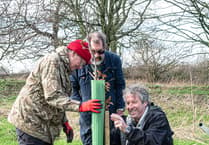Somerset Wildlife Trust is pleased to be able to launch the Somerset State of Nature Report 2023. The first of its kind for Somerset, and leading on from the national State of Nature Report released this year, the Somerset State of Nature Report 2023 is a comprehensive overview of the county’s landscapes, and highlights, where data allows, trends in the abundance and distribution of species and quality of habitats, identifying the key pressures wildlife is facing.
The report provides an important benchmark of how nature and wildlife is faring across the county, identifying both positive and negative trends, and contextualising how global and national declines in biodiversity are also being felt in Somerset. The report also features positive case studies which demonstrate key successes, and outlines planned approaches to restore Somerset’s natural environments in the face of known and emerging challenges, and to help meet the county’s 2030 environmental targets.
Key report findings include:
Habitats in Somerset have seen dramatic decreases in species richness since 1990, with terrestrial insects deteriorating most significantly.
Somerset has lost 5.14% of its total grassland habitats, with some areas significantly higher at 11.5%.
Butterfly distribution has declined by 874km2 over 30 years; fritillary butterflies have suffered most drastically, with a 60% decline in distribution from 1990 to 2021.
Notable species declines include Lapwing. Lapwing records from 1994 to 2023 have declined to worrying levels, suggesting that over time, the availability of suitable breeding habitat for this distinctive bird has reduced in Somerset.
Between 2009 and 2019, the number of ‘Good’ quality rivers in Somerset have decreased from 38 to 21 .
Non-native invasive species cover has increased by 260%, from 354km2 to 923km2 between 1990-2021, with 37 species recorded.
Only 36% of the 128 Sites of Special Scientific Importance (SSSI) in Somerset were assessed as favourable.
Somerset’s 73km coastline, and the species that call it home, were found to be under threat as a result of climate change, rising sea levels and other contributing factors outlined within the report.
Following national trends, it’s clear that Somerset’s ecosystems have been impacted by climate change, changes in land management, development and pollution; and invasive species and diseases are further threatening habitats.
Despite a number of unfavourable findings, the report however also captured some positive trends and highlighted case studies demonstrating real success:
Some mammal species are thriving; the return of beavers in Somerset has seen positive feedback - the county’s first ‘recorded’ kits were born this year.
Wading bird populations, such as great white egret and bittern, have seen increases as a result of recent projects, particularly on the Avalon Marches.
Marsh harrier and bearded reedling are also benefitting from collaborative efforts by partners to enhance reedbed habitats.
Other species doing well in Somerset include the four-spotted chaser, orange-tip butterfly, buzzard, bittern, great spotted woodpecker and goldfinch.
There are also positives in terms of potential for expanding the Nature Recovery Network:
At 2,200, Somerset has the second-largest number of Local Wildlife Sites (LWS) in the UK. Important wild spaces for wildlife, they are important building blocks within the nature recovery network and can buffer and protect existing protected sites within the wider landscape too.
Priority habitats across Somerset, identified as being the most threatened and which require conservation action, are increasing.
In 2022, the Somerset Wetlands ‘super’ National Nature Reserve (NNR) brought together nature reserves and land within the wider Somerset Levels and Moors, bringing an additional 56% more land to the area occupied by the original NNR sites.
A similar ‘super’ NNR was declared this year in the Mendip Hills, meaning Somerset is the only county to have two of these very special sites.
Simon Clarke, Head of Nature Recovery says: “In many ways, the Somerset State of Nature tells us what we already know; that the pressure on our natural environment locally matches many of the national trends as outlined by the national report earlier this year; the quality and connectedness of the very distinct and special habitats we have here in Somerset are both at risk of further decline and the ecosystem functions that provide us clean air and water are waning, and with them, populations of precious wildlife both rare and common.
“However, if you reach beyond despondency, what you can see and grasp are real seeds of real hope. Because what the report also highlights very clearly, is that where there has been focused effort on a landscape-scale, underpinned by a truly meaningful and committed partnership approach to nature restoration, the results can be simply outstanding.
“Within our county, these seeds of hope, these cases studies of success must act as lodestars for all that we do going forwards. What is vital now is that we are able to align quickly and work in partnership with all other nature stakeholders across the county and, with the support of a strong Local Nature Recovery Strategy (LNRS), identify where we must place our collected efforts. The state of Somerset’s nature is for us all to own, and this new report provides us with a baseline; a reference point for the actions we take going forwards.”
Ellen Phillpot, Records Centre Support Officer, Somerset Environmental Record Centre (SERC) explains more: “It’s ever more critical that we make smart decisions as to where best to direct our collective efforts to restore nature across the county – and these efforts must be based on strong science and evidence. Whilst the Somerset State of Nature Report is based on the best data and information available from the huge range of amazing recorders across the county and Somerset Environmental Records Centre, there are gaps in our knowledge that we need to fill.
“This is the first Somerset State of Nature Report. We hope to use new technologies, to enhance our data collection and analysis, so in consequent editions will be able to more accurately report patterns and trends across the county. Growing a wider citizen science community across the county is also vital.
“We need more eyes and ears on the ground, whether that’s individuals, specialist groups or communities – it’s something everyone can do to make a contribution to nature’s recovery.”
To download a full copy of the Somerset State of Nature 2023 report, visit: www.somersetwildlife.org/stateofnature2023



